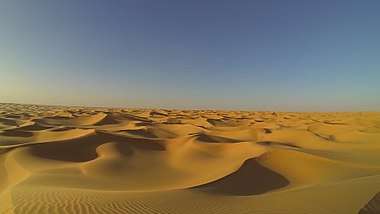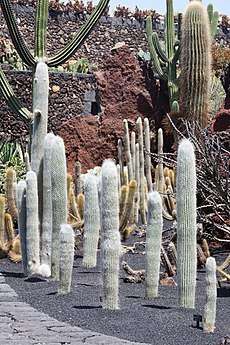Desert ecology

Desert ecology is the study of interactions between both biotic and abiotic components of desert environments. A desert ecosystem is defined by interactions between organism populations, the climate in which they live, and any other non-living influences on the habitat. Deserts are arid regions which are generally associated with warm temperatures, however cold deserts also exist. Deserts can be found on every continent, with the largest being located in Antarctica, the Arctic, Northern Africa, and the Middle East.
Climate
Deserts experience a wide range of temperatures and weather conditions. They can be classified into four types: hot, semiarid, coastal, and cold. Hot deserts have warm temperatures at all times of the year, and low annual precipitation. The lack of humidity in these deserts results in high temperatures during the daytime and large amounts of heat loss at night. Although the average annual temperature in hot deserts is 20 °C to 25 °C, extreme weather conditions can lead to temperatures from -18 °C to 49 °C. Rainfall generally occurs in concentrated bursts, followed by long periods of no precipitation. Semiarid deserts experience similar conditions to hot deserts, however the maximum and minimum temperatures tend to be less extreme, ranging from 10 °C to 38 °C. Coastal deserts are cooler than hot and semiarid deserts, with average summer temperatures between 13 °C and 24 °C. They also feature higher total rainfall values. Cold deserts are similar in temperature to coastal deserts, however they receive more annual precipitation, which much of it in the form of snow.[1] Deserts are most notable for their dry climates resulting from rain-blocking mountain ranges and remoteness from oceanic moisture. Deserts occupy one-fifth of the Earth's land surface and occur in two belts: between 15° and 35° latitude in both the southern and northern hemispheres.[2] These bands are associated with the high solar intensities that all areas in the tropics receive, and at the same time with dry air brought down by the descending arms of Hadley and Ferell atmospheric circulation cells.
Deserts generally occur because of global wind patterns or rain shadows. Dry winds not only hold little moisture for these areas, but also tend to evaporate any water present. Rain shadows do not occur because of general wind patterns but rather, due to the wind passing over a mountain range. As air rises and cools, its relative humidity increases and some or most moisture rains out, leaving little to no water vapour to form precipitation on the other side of the mountain range.
Many desert ecosystems are limited by available water levels, rather than rates of radiation or temperature. Water flow in these ecosystems can be thought of as similar to energy flow; in fact, it is often useful to look at water and energy flow together when studying desert ecosystems and ecology.[3]
Water availability in deserts may also be hindered by loose sediments. Dust clouds commonly form in windy, arid climates. Scientists have previously theorised that desert dust clouds would enhance rainfall, however some studies have shown that precipitation is actually inhibited by this phenomenon by absorbing moisture from the atmosphere. This absorption can result in a positive feedback loop, which leads to further desertification.[4]
Landscape
Desert landscapes can contain a wide variety of geological features, such as oases, rock outcrops, dunes, and mountains.[5] Dunes are structures formed by wind moving sediments into mounds. Desert dunes are generally classified based on their orientation relative to wind directly. Possibly the most recognisable dune type are transverse dunes, whose crests are transverse to the wind direction. Many dunes are considered to be active, meaning that they travel and change over time due to the influence of the wind. However, some dunes can be anchored in place by vegetation or topography, preventing their movement.[6] Some dunes may also be referred to as sticky, which occurs when the individual grains of sand become cemented together. Sticky dunes tend to be more stable and resistant to wind reworking than loose dunes.[7]
Analysis of geological features in desert environments can reveal a lot about the history of the area. Through observation and identification of rock deposits, geologists are able to interpret the order of events that occurred during desert formation. For example, research conducted on the surface geology of the Namib Desert allowed geologists to interpret ancient movements of the Kuiseb River based on rock ages and features identified in the area.[8]
Organism Adaptation
Animals
Deserts support diverse communities of plant and animals that have evolved resistance to, and methods of circumventing of, the extreme temperatures and arid conditions. For example, desert grasslands are more humid and slightly cooler than its surrounding ecosystems. Many animals get their energy by eating plants, but desert plants give up the fruit of their production very reluctantly.[9] To avoid intense temperatures, the majority of small desert mammals are nocturnal, and dig burrows in which they live. These burrows help maintain to prevent overheating and resulting loss of water, and to maintain the mammal's optimal temperature.[10] Desert ecology is characterized by dry, alkaline soils, low net production and opportunistic feeding patterns by herbivores and carnivores. Other organisms' survival tactics are physiologically based. Such tactics include the completion of life cycles ahead of anticipated drought seasons, and storing water with the help of specialized organs.[11]
Desert climates are particularly demanding on endothermic organisms. In environments where the external temperature is less than their body temperature, most endotherms are able to balance heat production and heat loss to maintain a comfortable temperature. However, in deserts where air and ground temperatures exceed body temperature, endotherms must be able to dissipate the large amounts of heat being absorbed in these environments. In order to cope with extreme conditions, desert endotherms have adapted through the means of avoidance, relaxation of homeostasis, and specializations. Nocturnal desert rodents, like the kangaroo rat, will spend the daytime in cool burrows deep underground, and emerge at night to seek food. Birds are much more mobile than ground-dwelling endotherms, and can therefore avoid heat-induced dehydration by flying between water sources. To prevent overheating, the body temperatures of many desert mammals have adapted to be much higher than non-desert mammals. Camels, for example, can maintain body temperatures that are about equal to typical desert air temperatures. This adaptations allows camels to retain large amounts of water for extended periods of time. Other examples of higher body temperature in desert mammals include the diurnal antelope ground squirrel, and the oryx. Certain desert endotherms have evolved very specific and unique characteristics to combat dehydration. Male sandgrouse have specialized belly feathers that are able to trap and carry water. This allows the sandgrouse to provide a source of hydration for their chicks, who do not yet have the ability to fly to water sources themselves.[12]

Plants
Although deserts have severe climates, some plants still manage to grow. Plants that can survive in arid deserts are called xerophytes, meaning they are able to survive long dry periods. Such plants may close their stomata the daytime and open them at night, at the time when a plant may load carbon dioxide while, thanks to lower temperatures, losing less water to evaporation.
Adaptations in xerophytes include resistance to heat and water loss, increased water storage capabilities, and reduced surface area of leaves. One of the most common families of desert plants are the cacti, which are covered in sharp spines or bristles for defence. The bristles on certain cacti also have the ability to reflect sunlight, such as those of the old man cactus. Certain xerophytes, like oleander, feature stomata that are recessed as a form of protection against hot, dry desert winds, which allows the leaves to retain water more effectively. Another unique adaptation can be found in xerophytes like ocotillo, which are "leafless during most of the year, thereby avoiding excessive water loss".[13]
Exploration and Research
The harsh climate of most desert regions is a major obstacle in conducting research into these ecosystems. In the environments requiring special adaptations to survive, it is often difficult or even impossible for researchers to spend extended periods of time investigating the ecology of such regions. To overcome the limitations imposed by desert climates, some scientists have used technological advancements in the area of remote sensing and robotics. One such experiment, conducted in 1997, had a specialised robot named Nomad travel through a portion of the Atacama Desert. During this expedition, Nomad travelled over 200 kilometres and provided the researchers with many photographs of sites visited along its path.[14]
See also
References
- ↑ Pullen, Stephanie. "The Desert Biome". University of California Museum of Paleontology. Retrieved 7 November 2017.
- ↑ "World Deserts". Mojave National Preserve: Desert Ecology. National Park Service. Retrieved 2008-02-22.
- ↑ Noy-Meir, Imanuel (1973-11-01). "Desert Ecosystems: Environment and Producers". Annual Review of Ecology and Systematics. 4 (1): 25–51. doi:10.1146/annurev.es.04.110173.000325. ISSN 0066-4162.
- ↑ Rosenfeld, Daniel; Rudich, Yinon; Lahav, Ronen (22 May 2001). "Desert dust suppressing precipitation: A possible desertification feedback loop". Proceedings of the National Academy of Sciences of the United States of America. 98 (11). doi:10.1073/pnas.101122798. PMC 33408.
- ↑ "Desert Features". U.S. Geological Survey. Retrieved 7 November 2017.
- ↑ Edgell, H. Stewart (2006). Arabian Deserts. Springer. pp. 201–238. ISBN 978-1-4020-3970-6.
- ↑ Hesse, Paul (15 November 2011). "Sticky dunes in a wet desert: Formation, stabilisation and modification of the Australian desert dunefields". Geomorphology. 134 (3–4): 309–325. doi:10.1016/j.geomorph.2011.07.008.
- ↑ Eckardt, Frank D.; Livingstone, Ian; Seely, Mary; Von Holdt, Johanna (17 October 2013). "The Surface Geology and Geomorphology Around Gobabeb, Namib Desert, Namibia". Geografiska Annaler. 95: 271–284. doi:10.1111/geoa.12028.
- ↑ "Desert Ecosystem". digital-desert.com. Retrieved 2017-05-03.
- ↑ Whitford, Walter G. (2002). Ecology of Desert Systems. San Diego, California: Elsevier Science Ltd. pp. 128, 132. ISBN 0127472614.
- ↑ Cloudsley-Thompson, J.L. (1996). "Current trends in desert ecology". Science Progress. 79 (3): 215–232. JSTOR 43423916.
- ↑ Pough, F. Harvey; Janis, Christine M.; Heiser, John B. (2013). Vertebrate Life (9th ed.). Pearson. pp. 549–556. ISBN 978-0-321-77336-4.
- ↑ Reece, Jane B.; Urry, Lisa A.; Cain, Michael L.; Wasserman, Steven A. (2012). Campbell Biology Canadian Edition. Pearson. p. 835. ISBN 978-0-321-77830-7.
- ↑ Wettergreen, David; Bapna, Deepak; Maimone, Mark; Thomas, Geb (28 February 1999). "Developing Nomad for robotic exploration of the Atacama Desert". Robotics and Autonomous Systems. 26 (2–3): 127–148. doi:10.1016/S0921-8890(99)80002-5.